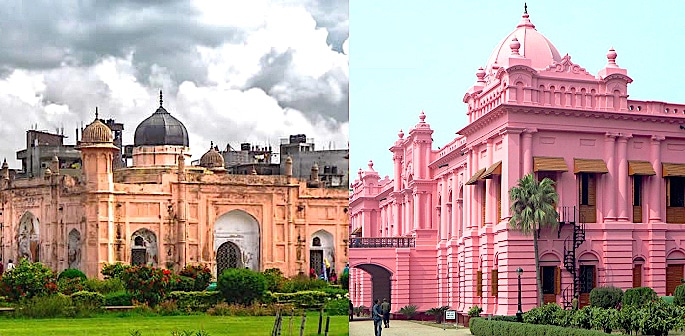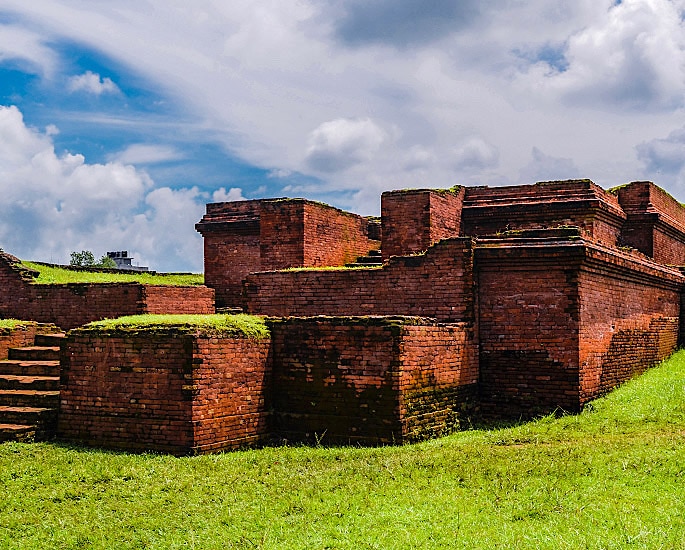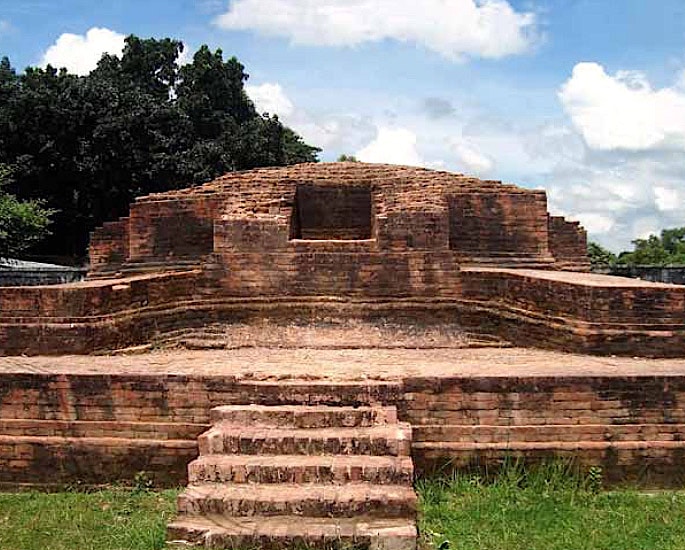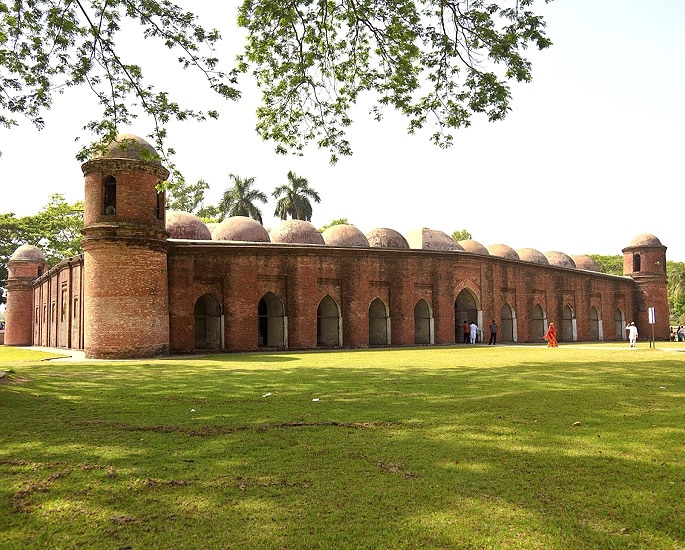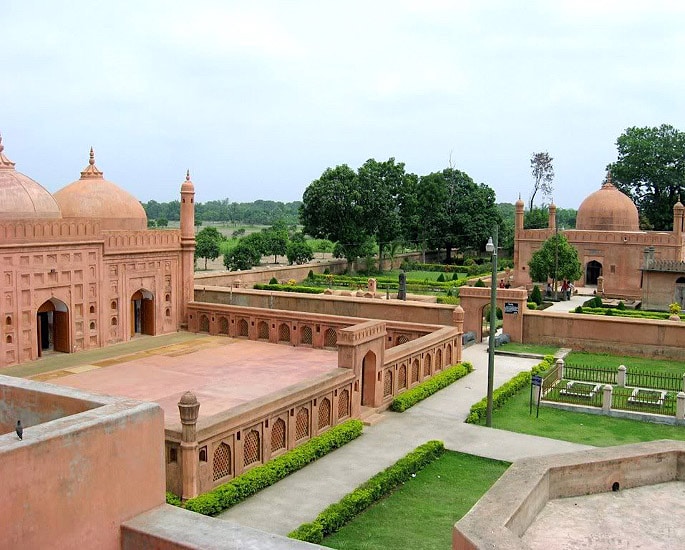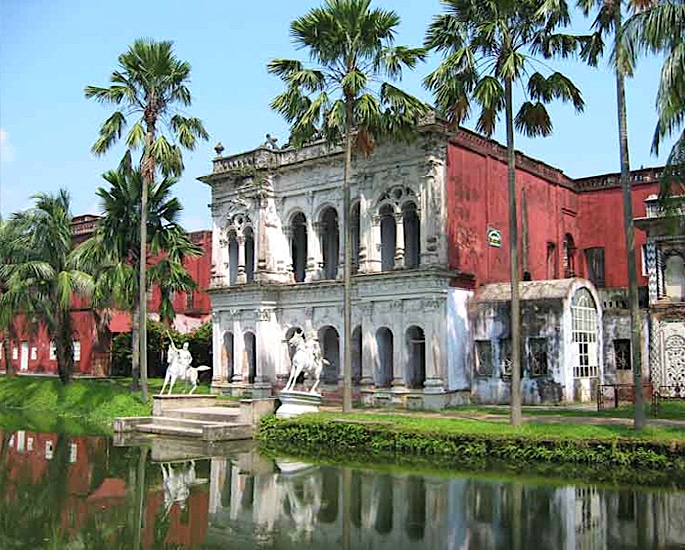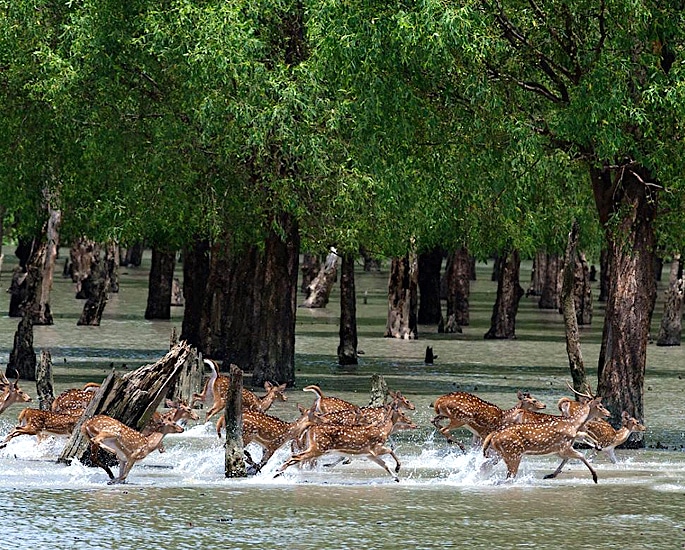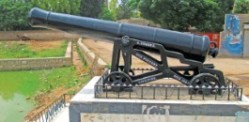"The fine architecture will blow your mind."
Besides natural beauty, Bangladesh is a country with many historical heritage sites.
The South Asian nation has majestic man-made monuments, along with natural formations like forests and landscapes to admire.
Many of the archaic sites offer a rich history, especially for people who want to increase their knowledge about the jewels of Bangladesh.
People who make the voyage to this part of the world will get to see superb archeological works from the ancient period.
Many of the sites have UNESCO (United Nations Educational, Scientific and Cultural Organization) world heritage status.
Bangladesh invites all people to explore and immerse themselves into the history and culture of the region.
DESIblitz presents 10 top historical heritage sites to visit and explore in Bangladesh:
Mahasthangarh, Bogra
Mahasthangarh is one of the earliest archaeological structures that was unravelled in Bangladesh. The site is located 11 kilometres from Bogra and closer to the Bogra-Rangpur highway.
Known as Mahasthan, the lost village dates back to the early 3rd century as predicted from a limestone.
The limestone had inscribed words that dated back to this time and was only found in 1931.
Mahasthan in the Bogra District is what remains of this ancient city. It was previously known also as Pundranagara or Paundravardhanapura.
The centre of the city, known as the Citadel, is the heart of the ‘Garh’ meaning ‘fort.’ The rectangular plan of the structure is almost 185 hectares.
Alongside this runs the river Karatoya, which was once a doughty river. It now is reduced to the size of a small stream.
It is believed that the people who used to occupy this forgotten city, used it as a means of transportation and agricultural benefits.
Visitors who go to Bogra describe Mahasthangarh as an ‘incredible historic place’ that offers great insight into the lives of others.
The city was in use until the 18th century when nature took over, turning it into a beautiful green landscape. Mahasthangarh is the oldest known city of Bangladesh.
Excavations which begun and still are underway since the discovery of the city have revealed many key artefacts.
From coins, ceramics, sculptures and more, these artefacts can be seen at the site museum open from Sunday to Thursday.
Somapura Mahavira, Naogaon
Somapura Mahavira also familiar as ‘Paharpur Mahavihar’ is a beautiful and earthy looking monastery. The 80 feet tall structure in the Naogaon region goes back as far as the 8th century AD during the Pala Empire.
The structure is intricate with a quadrangular shape and a traditional stupa in the centre.
Around 177 cells surround the site where monks once did use for meditation and accommodation. The monastery did also house many spiritual scholars and individuals.
Alongside the cells and stupas, researchers did discover coins, plaques, structures and various other artefacts.
Most of the findings from past excavators are visible in the adjacent museum across the attraction.
Somapura became a UNESCO world heritage site in 1985. Since then, to preserve the site, relevant authorities carry out regular building work.
Tourists find the sight brings an element of peace, with its fresh air and rich history. A tourist on Tripadvisor describing the site mentions:
“A nice historical place of Bangladesh.”
“This place Not only had a good research place for archaeologist or historic place lovers but also, its a nice day out place for all ages people.”
Shalban Vihara, Comilla
Shalban Vihara is a crucial site as part of the Mainamati remnants in the Comilla district.
From the 7th and 12th century, Mainamati was an important centre for Buddhism.
The site founded by Bhava Deva, the fourth ruler of the Deva Dynasty lies in a 168 square metres area. The site is in the middle of the Lalmai Hills Ridge.
Barren land and forest surround this wonderful archeological structure in an area, which is very natural and serene.
The flamingly woody colour building was a lodging place for 115 monks. Prior to being a monastery, it was formerly familiar as Shalban Rajar Bari.
After discovering copper artwork when digging the soil, the site then went by the name of Shalban Vihara.
The Comilla district has great transport systems, with both Dhaka and Comilla linked with railway stations.
Tourists and visitors often say that it is a great area to escape to from the hustle and bustle from Dhaka’s busy street life.
A social media user describes Shalban Vihara as a “beautiful place.”
Another talking of its significance mentions:
“Arguably the most essential Buddhist archaeological site in Bangladesh is the Shalban Buddha Vihara.”
Kotila Mura, Comilla
Located in Comilla Adarsho Sadar Upazila, Comilla District, Bangladesh, Kotila Mura is one of the fifth spots between the Mainamati remains. This place goes back to 600 AD.
In terms of style, this site has more of a traditional structure, whereas other Mainamati ruins have a more evolving style.
This historical site is on top of a mound, which has three spiritual elements, including Dharma, Sangha and the Buddha.
The only route to this place is from the North Eastern direction, an opening which takes you to a massive hall. There was also chamber to the exterior of the hall.
Excavation evidence suggests this structure was active from the 7th to 13th century.
During excavations, researchers did retrieve a gold coin of Mu’tasim Billah, the final Abbasid Caliph (1242 – 1258) from the site.
Other artefacts researchers did collect from the site include broken parts of a stone structure and relics from that time.
As a result of its rich history, it has become a major tourist spot for people visiting Bangladesh.
Jagaddala Mahavihara
Founded by the later kings of the Pala Empire, Jagaddala Mahavihara is present in the northern areas of Bangladesh, close to the Jaggadala village.
Jagaddala was a monastery dating back to the 11th-12th century.
UNESCO supported excavations verify this was a monastery.
A report by UNESCO reveals an “an extensive mound, 105 metres long by 85 metres, which represents the archaeological remains of a Buddhist monastery…finds have included terracotta plaques, ornamental bricks, nails, a gold ingot and three stone images of deities.”
Jagaddala Mahavihara is the only vihara discovered and dug in Bangladesh, which has a rooftop with an approximate 60 cm thik.
Amiya Basu, publisher of the Bengali railway guide Banglay Bhraman in the early 40s mentions a fascinating account of the Jagaddala ruins. It discovers:
“At a distance of about 3 miles from the Gurava Stambha (pillar) near the river Chiri or Sri, there is a circular stupa (actually mound) with a circumference of about 1000 ft.
“There is another stupa, measuring 225.”
According to UNESCO, Jagaddala remains a tentative site, which the World Heritage Committee may examine as a cultural nomination for the World Heritage list.
Sixty Domes, Bagerhat
The Sixty Domes is also familiar as the Shait Gambuj Mosque or Saith Gunbad Masjid.
This spiritual place received designation as a UNESCO world heritage site in 1985 as a cultural building.
From the Sultanate period, it is also the largest mosque in the country. The location of Sixty Domes is also in Bagerhat, Khulna Division, Bangladesh.
Construction of this mesmerising place began in 1442, with its completion in 1459.
The breath-taking site is 160 feet long and 108 feet wide. Visitors describe this spiritual place as a stunningly designed building.
Although called the Sixty Dome Mosque, the building actually consists of 77 low domes, along with 4 in each corner making it 81.
The inside is as marvellous as the exterior, with identical archways, stretching out to support the roof.
Along with the sixty domes, there is also sixty pillars that support the uphold and weight of the 60 domes.
A visitor to this place reviewing on google expresses:
“Heritage Site of Bangladesh. A must see place if you are in Khulna.”
“The fine architecture will blow your mind.”
The Lost City of Bagerhat
The location of this historic city is in the south west of Bangladesh.
The city is where the river Brahmaputra and the Ganja river meet in the Khulna division. Bagerhat comes under the Forbes 15 lost cities in the world.
In 1985, the site gained recognition as a UNESCO world heritage site.
A Turkish man by the name of Ulugh Khan Jahan is the founder of this place. The beautiful curation from the 15th century is made up of bricks.
Familiar as Khan Jahan Ali (1369-25 October 1459), reportedly he was also the constructor of the Sixty Dome Mosque.
The mosque city once was once famous as Khalifatabad during the reign of Ali.
Jahan had many followers from Khalifatabad, stretching from Naldi to the north of Narail.
As per reports, Khan did acquire an area of the Sundarbans and set up human structures.
The city has baked bricks consisting of many ruins and structures. These include 360 places of worship, bridges, roads and other man-made constructions.
Architecturally beautiful, the city uses a distinctive style of designs often familiar as the ‘Khan Jahan Style.’
The style and designs within the beautiful and untouched city have Turkish architectural influences.
Thousands of people visit Bagherhat to see the stunning scenery of the remote city.
Tourists can also visit a UNESCO collaborative museum in the lost city. This museum showcases antiques discovered in the lost city and uncovers the full history of Bagerhat.
Lalbagh Fort, Dhaka
The Lalbagh Fort on Lalbagh Road in Dhaka never got to full completion, with the commissioning of the building starting in 1678 AD.
Mughal emperor Azam Shah (28 June 1653 – 8 June 1707), began the work om the magnificent structure. Staying in Bengal for nearly 15 months, the fort came to a halt when he had to return back home during the war period.
Under a new ruling, Mughal general Shaista Khan (1600–1694) had to complete the work of the building.
In 1684 though, Shaista’s daughter, Pari Bibi met her death in the fort. The new Governor of Bengal saw the fort as bad luck and a place of misfortune.
So losing his daughter and refusing to complete the fort, the building had no occupancy. In fact, Pari Bibi’s tomb resides in the building alongside two others.
For a long time, people were thinking the fort has three structures. These include a place of worship, the tomb of Pari Bibi and a residential quarter known as Diwan-i-Am.
But excavations within the fort reveal that this site also comprises of other structures.
The fort and surrounding garden give an extraordinary vision into the overall look of the structures. Many myths and legends surround the incompletion of the building.
The fort is made under two tunnels leading amongst the Zinzira Fort ruins.
There was also a maze that did eventually close. The closure came about after claims by people that anyone entering the maze did not return back.
To certify the claim, British researchers sent in dogs and elephants. but the animals never came back.
This beautiful fort surrounded by contributing structures. makes it a breathtaking site, almost transporting you to another time.
The fort is rumoured with various myths and legends.
Ahsan Manzil, Dhaka
What is now a national museum, Ahsan Manzil was once a beautiful residential palace.
The location of the glorious building is along the banks of the River Buriganga in Dhaka.
The Ahsan Manzil Palace is famous for its pinkish colour. Hence people are familiar with this site also by the name of Pink Palace.
The pink tone of the palace is what makes it so distinctive. The building work of the palace began in 1859, completing the enormous job in 1872.
The elegant design of the building has an Indo-Saracenic Architectural style.
In the Mughal era, Sheikh Inayat Ullah (1843-1846), the landowner of this place built this site amongst a big area covering his summer house.
Sheikh apparently had placed beautiful girls around the nation, dressed in lavish clothing for his pleasure.
But there are reports that the Emperor of Dhaka had fallen in love with one of the girls that Sheikh Enayat had housed.
So in an effort to pursue his love, the Emperor invited the Sheikh to a staged party and murdered him.
Sadly, the girl was filled with sorrow and guilt and committed suicide out of anger, leaving the Emperor to face the consequences.
The remains of Sheikh’s grave can be found in the north-west of the courtyard, which was mostly ruined in the 20th century.
In 1985, the building was acquired by the government of Bangladesh and since then has been renovated.
The building was established as a museum on September 20, 1992.
Thousands of people flock to the museum as it holds significant value to Bangladesh history and the architectural evolution of the country.
Visitors have reviewed the palace as one of the ‘most iconic historic buildings of Bangladesh’, with preservation of the palace being immaculate.
The Sundarbans
The name ‘Sundarbans’ meaning ‘beautiful forest’ is a mangrove forest consisting of 140,000 hectares.
The name originally derives from the word ‘Samudraban’ meaning ‘sea forest’ with rivers and sea-water surrounding it.
In 1997, the beautiful forest became a natural UNESCO world heritage site. The forest is also famous for housing the dangerous Bengal Tigers.
This part of Bangladesh has international recognition for having mangrove trees and shrubs growing on land and water.
Other than the tigers, the forest is home to around 260 different species of birds and consists of the famous Indian Python.
Situated in the southwestern region of Bangladesh, it spans over the Delta of the Ganges and the Meghna Rivers in Bengal Bay.
Not only does the forest attract thousands of tourists, but researchers find this part of Bangladesh extremely fascinating.
Scientific research and observations are regularly taking out on the co-inhabitants of plants and animals.
1865 saw the introduction of The Forest Act for the protection of the Sundarbans’ biodiversity and ecosystem.
One main factor for passing this law was illegal hunting, which is why the Bengal Tigers are nearly extinct.
Despite reports of human and tiger conflicts, with the right tour guide, this haven is a great creation of mother nature.
The forest traces back to 200 to 300 AD during the Mughal period.
The Mughal kings leased the forest out to criminals who would live in the forest.
Many of the people who did reside in the forest have had to face attacks by tigers. This is why the forest consists of a small number of abandoned infrastructures such as huts and paddy fields.
There is no doubt that there is a significant amount of historical heritage sites in Bangladesh.
The beauty of the country is only intensified by the rich history and culture that originates from it.
Over 600,000 tourists visit Bangladesh and experience the beautiful landscapes and history that the country has to offer.
History is important for the understanding of the times before now. Furthermore, this country gives great insight into the exotic past lives from a different generation.



















































